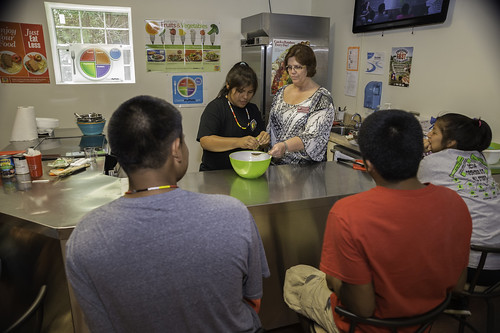
“How many of you like vegetables?” The question posed to a gathering of Choctaw children in a garden in rural Mississippi elicits skeptical responses. But upon sampling the fresh produce harvested with their own hands, however, the children’s stereotypes of disgust turn to surprises of delight. A young boy taking a giant bite out of a juicy tomato could be the poster child for the vibrant red fruit. A pair of sisters declares cucumbers as their favorite. The newly adventurous children are even willing to taste raw eggplant…Now that’s impressive.
Through a summer program made possible by a Food Distribution Program Nutrition Education (FDPNE) Grant from the Food and Nutrition Service, 150 children from the Mississippi Band of Choctaw Indians were able to get up close and personal with fresh fruits and vegetables. Twice a week, children ages 6-18 from the Boys and Girls Club and the Tribal Youth Court participated in the lifecycle of planting, picking, and preparing produce. The week my colleagues and I visited the Choctaw Indian Reservation, the children scattered seed for iron clay peas, witnessed the hustle and bustle of a farmers market, and learned how to dice vegetables for a salsa recipe.
Local farmers and educators partnered in the endeavor. Throughout the summer, Dick Hoy of Choctaw Fresh Produce, a tribal enterprise, introduced groups of children to his high tunnel gardening methods. Hoy recognizes the value of getting involved with agriculture at an early age. When Hoy was 6 years old, his grandfather gave him a patch of land and instructed him to grow watermelons. Hoy sold them for 50 cents apiece at the general store. Half a century later, he shares his passion for sustainability and food sovereignty with the next generation.
Hands-on cooking demonstrations by nutrition educators from the Mississippi State Extension Service complemented the garden tours. Supporting the grant program’s MyPlate goal to “make half your plate fruits and vegetables,” the children learned one fruit recipe and one vegetable recipe each week. Given the target audience of children from households eligible for the Food Distribution Program on Indian Reservations (FDPIR), the recipes also sought to incorporate products available in the FDPIR food package. FDPIR is an alternative to participation in the Supplemental Nutrition Assistance Program (SNAP).
“Our biggest nutrition concerns here are diabetes and obesity,” said Laura Huff, nutritionist at the Mississippi Band of Choctaw Indians Food Distribution Program. “My main target through the summer grant program is to teach kids about fruits and vegetables and the importance of staying physically active to decrease the risk of diabetes and obesity.”
Through this summer’s enlightening experiences in the gamut of gardening – sowing and reaping, cooking and eating – Mississippi Choctaw children learned about the value and provenance of fresh fruits and vegetables. The partnerships that made this program possible showcase innovative strategies for investing in nutrition education.
